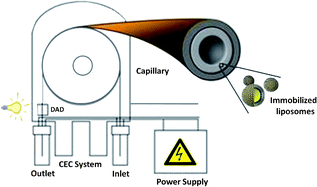Covalent binding of phospholipid vesicles on fused silica capillaries for electrochromatography
Abstract
A rapid method for covalent binding of

* Corresponding authors
a
Laboratory of Analytical Chemistry, Department of Chemistry, POB 55, University of Helsinki, Finland
E-mail:
susanne.wiedmer@helsinki.fi
Fax: +358 9 191 50253
Tel: +358 9 191 50264
b Division of Biopharmaceutics and Pharmacokinetics, Faculty of Pharmacy, POB 56, University of Helsinki, Finland
A rapid method for covalent binding of

 Please wait while we load your content...
Something went wrong. Try again?
Please wait while we load your content...
Something went wrong. Try again?
J. Lokajová, H. Tiala, T. Viitala, M. Riekkola and S. K. Wiedmer, Soft Matter, 2011, 7, 6041 DOI: 10.1039/C1SM05372H
To request permission to reproduce material from this article, please go to the Copyright Clearance Center request page.
If you are an author contributing to an RSC publication, you do not need to request permission provided correct acknowledgement is given.
If you are the author of this article, you do not need to request permission to reproduce figures and diagrams provided correct acknowledgement is given. If you want to reproduce the whole article in a third-party publication (excluding your thesis/dissertation for which permission is not required) please go to the Copyright Clearance Center request page.
Read more about how to correctly acknowledge RSC content.
 Fetching data from CrossRef.
Fetching data from CrossRef.
This may take some time to load.
Loading related content
